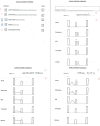A prospective study on the efficacy of patient simulation in heart and lung auscultation
- PMID: 31337361
- PMCID: PMC6651929
- DOI: 10.1186/s12909-019-1708-6
A prospective study on the efficacy of patient simulation in heart and lung auscultation
Abstract
Background: The use of simulation technology for skill training and assessment in medical education has progressively increased over the last decade. Nevertheless, the teaching efficacy of most technologies remains to be fully determined. The aim of this prospective study was to evaluate if a short individual training on a patient simulator could improve heart and lung auscultation skills in undergraduate students.
Methods: A group of fifth-year medical school students, who had trained on a patient simulator in their third year (EXP, n = 55), was compared to a group of fifth-year medical school students who had not previously trained on it (CNT, n = 49). Students were recruited on a voluntary basis. Students were evaluated in terms of their ability to correctly identify three heart (II sound wide split, mitral regurgitation, aortic stenosis) and five lung sounds (coarse crackles, fine crackles, pleural rubs, rhonchi, wheezes), which were reproduced in a random order on the Kyoto-Kagaku patient simulator.
Results: Exposure to patient simulator significantly improved heart auscultation skills, as mitral regurgitation was correctly recognized by 89.7% of EXP students as compared to 71.4% of CNT students (p = 0.02). In addition, a significantly greater percentage of EXP students correctly graphed all the heart diagnoses as compared to CNT students. There were no differences between the groups in lung auscultation.
Conclusions: This study demonstrates that training medical students with a patient simulator, individually for one hour, significantly ameliorated their heart auscultation skills. Our data suggests that patient simulation might be useful for learning auscultation skills, especially when it is combined with graphic sound display.
Keywords: Clinical education; Heart auscultation; Lung auscultation; Medical education; Medical semiotics; Patient simulation; Patient simulators.
Conflict of interest statement
The authors declare that they have no competing interests
Figures


References
-
- Ewy GA, Felner JM, Juul D, Mayer JW, Sajid AW, Waugh RA. Test of a cardiology patient simulator with students in fourth-year electives. J Med Educ. 1987;62(9):738–743. - PubMed
MeSH terms
LinkOut - more resources
Full Text Sources

